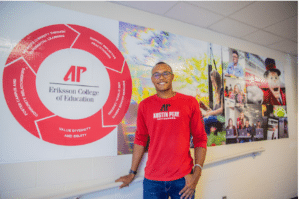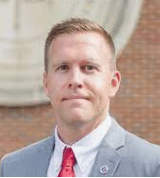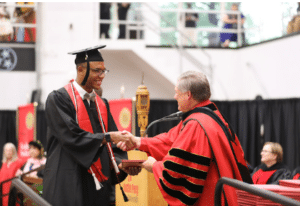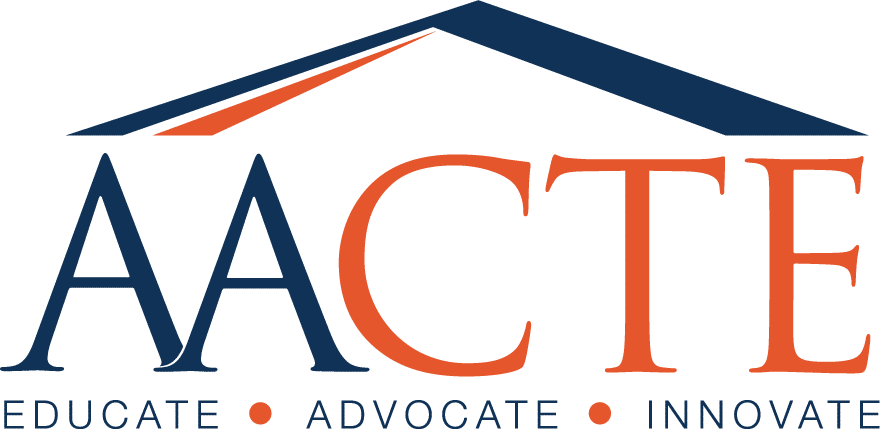Innovative Tennessee Teacher Prep Program Aims to Prepare a New Breed of Educators
This article originally appeared on reimaginED, the policy and public affairs communications platform for Step Up For Students and is reprinted with permission.

The Early Learning Residency Program at Austin Peay University proved to be what recent graduate Malachi Johnson was looking for: a college education and a guaranteed job.
In her 20s, Heather Fracker set her sights on becoming a respiratory therapist. But as John Lennon observed, “Life is what happens when you’re busy making other plans.”
Fast forward two decades, and Fracker, a 43-year-old single mom to two middle schoolers, is pursuing a new dream. In two years, she will be a fully credentialed elementary school teacher thanks to an accelerated program that began in her hometown.
“Never in a million years did I think I’d want to be a teacher,” Fracker said.

Heather Fracker, left, is working on a bachelor’s degree in education through Tennessee’s Early Learning Residency Program with help from her mentor, Belinda Cornell.
But subbing and volunteering in schools in her area changed her mind. She began working toward a childhood development associate credential to teach pre-kindergarten. Fracker did so well that the Tennessee Early Childhood Training Alliance, a statewide organization with locations at multiple colleges and universities, nominated her for the Early Learning Teacher Residency Program at Austin Peay State University, then in its third year.
“At first, I said no,” she said, “because my plan was already in place.”
But alliance leaders won her over by telling her it was a terrific opportunity, that she easily could add a pre-K endorsement by taking an exam. Now, Fracker is at the head of a third-grade classroom three days a week and working toward a bachelor’s degree in the evenings.
Going back to college in mid-life to pursue a new career can be prohibitive due to the cost and time commitment involved. But the Clarkesville-Montgomery County School System, and more recently, the state of Tennessee, are banking on individuals like Fracker who offer a solution to the teacher shortage and retention issues that have plagued the profession for years – a challenge that has become more severe as teachers leave traditional classrooms to start their own schools or choose not to teach in the first place.
In Tennessee, the “Grow Your Own” program started in 2018 as a partnership between the school system and Austin Peay, a public institution with 8,418 undergraduates.
Located about 12 miles south of the Kentucky state line and about an hour’s drive from Nashville, U.S. News & World Report ranked the university 41st out of 135 among regional colleges in the South.
The Clarksville-Montgomery County School System employs 2,550 teachers who are charged with delivering instruction to 37,900 students, half of whom are classified as economically disadvantaged. Almost 16% have disabilities, and 5% have a first language other than English.
Leaders at both organizations came up with the idea in response to shared concerns discovered during meetings aimed at improving their partnership. Chief among them: the critical teacher shortage.
“We both wanted to address the issue of the teacher shortage, of not having enough graduates in high needs areas, especially STEM, and we both wanted to add diverse students to our programs,” said Lisa Barron, associate dean of the Eriksson College of Education at Austin Peay.
The commiserating quickly turned to brainstorming.
“Once we really started getting serious about how we impact this, we realized that if we were to completely redesign teacher education, it probably would not look like what it does today,” Barron said.
For the program to be successful, the groups decided, several factors had to come together. It would have to attract individuals who were settled in their hometowns, preferably those already connected to schools, including volunteers, aides, custodians or bus drivers, or others without college degrees.
They agreed the program needed to be free to students and that it must be flexible enough for them to work and support their families while they trained. Additionally, they agreed, the program had to move faster than the traditional four-year university route, and it had to provide support in the form of wrap-around services to help students navigate challenges.

Prentice Chandler
“We sometimes have made becoming a teacher harder than it has to be,” said Ericksson College dean Prentice Chandler. “I know a university is not the easiest place to navigate, and that’s our fault.”
Chandler dismisses the notion that no one wants to be a teacher these days, advancing the idea that the teacher shortage can be solved by removing barriers to well-designed programs. Chief among those barriers, Chandler believes, is what he sees as a lack of cooperation between teacher prep programs and school districts.
“We train teachers and we let them loose, and you hire them, and that’s it, we’re done,” he said. “The responsibility of preparation of teachers belongs to colleges of education working in tandem with their school partners. Without that sort of paradigm shift, I don’t think any of this work happens.”
In its first year, the Early Learning Teacher Residency Program accepted 20 recent high school graduates and 20 Clarksville-Montgomery County teachers’ aides. The model in place at that time is basically the same today.
Participants are employed throughout the program as teachers’ aides in classrooms led by the school system’s most experienced and highly effective teachers at elementary schools in lower-income areas. As employees, they receive a salary and benefits. The supervising teachers receive a stipend for each participant they mentor.
During their three-year residency, candidates must master all state-required competencies. They also must pass all state-required certification exams. After the final school bell rings each day, participants take classes toward a bachelor’s degree in education. They study year round with no summer break. All costs, including tuition, fees, textbooks, and anything else associated with the program, are covered.
Initially, participants were split between the university and the school system. That changed in 2021, when the state took notice of the program and expanded it by awarding $100,000 grants among 13 higher education providers across the state.
“It’s accelerated, but it’s not easy,” said Sean Impeartrice, chief academic officer for the Clarksville-Montgomery County School System. He stressed that graduates get the same quality of training as traditional education majors.
Since the program’s inception, Austin Peay has forged partnerships with community colleges, which offer two-year education degrees at no cost to students. After earning a two-year degree, the students take their remaining classes from the university.
Once program participants graduate, they must spend at least three years teaching in the school districts where they did their residency.
Program administrators say the wraparound support participants receive is key to ensuring they successfully complete their training.
“We work really hard to get rid of the many barriers that residents may have,” said Lavetta Radford, the education pipeline facilitator for the Clarksville-Montgomery County School System. “They may be academic, financial, or related to mental health. Sometimes life happens. We have residents who have lost children, who are taking care of aging parents, had surgery, or they may just need a space to come and work.”
For Fracker, the biggest challenge has been trying to spend time with her children. Now, most of her evenings are reserved for study. The course terms have been condensed from 12 weeks to seven weeks, so the workload is heavier.
“I have had to have many heart-to-heart talks,” she said. “They ask for a lot of time I can’t give. I have to keep reminding them that mommy is doing this to give them a better life.”
Her mentor, Belinda Cornell, is always there to offer Fracker everything from tutoring to a word of encouragement.
“She brings great classroom management skills,” said Cornell, a 38-year teacher who supervises two residents in addition to Fracker. “She has really knocked it out of the park … I’m there supporting her, but she’s taking the lead now.”
Soon after it began, the program began garnering state and national attention. The state of Tennessee has expanded it to 13 universities that partner with 65 school districts.
In January, Tennessee became the first state in the nation to be approved by the U.S. Department of Labor to establish a permanent Grow Your Own apprenticeship program, with the Teacher Residency program established by Austin Peay and Clarksville-Montgomery County as the first registered apprenticeship program.
“Tennessee’s leadership in expanding its Grow Your Own program is a model for states across the country that are working to address shortages in the educator workforce and expand the pipeline into the teaching profession,” U.S. Secretary of Education Miguel Cardona said in a news release.
Cardona pointed out that the program could not be more urgent or necessary as educators attempt to recoup COVID-19 learning loss.

Malachi Johnson toyed with the idea of becoming a teacher while a senior in high school but was nervous about paying college tuition for four years. In August, he was among the first class to graduate from the “Grow Your Own” teacher training program at Austin Peay State University.
More recently, the Tennessee Department of Education and the University of Tennessee System, comprised of university campuses throughout the state, announced plans to establish a $20 million Grow Your Own center to bolster the pipeline programs. The state also is working with the Council of Chief State School Officers to launch similar programs in other states.
Impeartrice, the school system’s chief academic officer, acknowledged that the program has not completely solved the teacher scarcity problem but said it has helped shrink the shortage. About 160 residents are now enrolled in the program.
“If we didn’t have the program, we’d be 150 teachers short rather than 50 teachers short,” he said. “We can close that gap. That’s doable.”
In August, the school system was able to at least narrow the gap as Austin Peay State University graduated its first class of newly minted residents, ready to serve as full-time teachers in the Clarksville-Montgomery County School System.
“It’s crazy because the night of graduation, I go to work for an open house so I can meet my students,” said Malachi Johnson, who was hired at a local elementary school. “I am jumping right into it and can’t wait.”
Fracker agrees. She expects she’ll feel more like a veteran than a newbie when she graduates with three years of teaching experience on which to draw, fully prepared to embark upon her new dream.
Tags: school-university partnerships, shortage, student achievement, teacher quality






